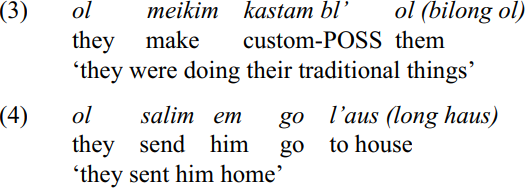


 Grammar
Grammar
 Tenses
Tenses
 Present
Present
 Past
Past
 Future
Future
 Parts Of Speech
Parts Of Speech
 Nouns
Nouns
 Verbs
Verbs
 Adverbs
Adverbs
 Adjectives
Adjectives
 Pronouns
Pronouns
 Pre Position
Pre Position
 Preposition by function
Preposition by function 
 Preposition by construction
Preposition by construction
 Conjunctions
Conjunctions
 Interjections
Interjections
 Grammar Rules
Grammar Rules
 Linguistics
Linguistics
 Semantics
Semantics
 Pragmatics
Pragmatics
 Reading Comprehension
Reading Comprehension|
Read More
Date: 2024-05-22
Date: 2024-04-24
Date: 2024-06-18
|
Wurm (1985) gives an account of stress patterns based on his experience of the rural pidgin spoken in the Eastern Highlands in the late 1950s and 1960s. He notes that there is considerable variability, with stress patterns more closely resembling those of English among speakers more familiar with English. In general, he notes that stress is normally on the first syllable. In some cases, there may be a non-stressed epenthetic vowel, and occasionally this may be re-interpreted by some speakers as a phonemic vowel and given stress. Some words do have stress on other than initial syllables, for example, the following stressed on the second syllable: orait ‘all right, then’, singaut ‘shout, call out’, sekan ‘shake hands’, sanap ‘stand up’ etc. Wurm notes that stress patterns are the basis for the patterns of intonation.
There is the possibility that different stress may disambiguate certain word pairs, although little work seems to have been done on this. Possible candidates would be the pairs 'nating ‘nothing’ and na'ting ‘I think, probably’, and 'palai ‘lizard’ and pa'lai ‘fly’, although I do not have definite evidence to show that this distinction is consistently made.
In the Tok Pisin of first language speakers and fluent second language speakers who use the language as a primary vehicle of communication, considerable reduction of stressed syllables can be observed (Smith 2002). Extreme samples of speech such as the following were encountered among young people:

One effect is the cliticisation of certain words such as long ‘in; on; at’ and bilong (possessive), especially when preceding vowels:

Cliticisation of aspect particles save (sa) ‘habitual’ and laik (la) ‘about to’ also appears to be in progress. Reduction can often be quite drastic, for example, the three-syllable utterance tso l’ sla taim recorded in the Highlands represents tasol long dispela taim ‘but at this time’ (maximally of seven syllables).
|
|
|
|
مخاطر خفية لمكون شائع في مشروبات الطاقة والمكملات الغذائية
|
|
|
|
|
|
|
"آبل" تشغّل نظامها الجديد للذكاء الاصطناعي على أجهزتها
|
|
|
|
|
|
|
تستخدم لأول مرة... مستشفى الإمام زين العابدين (ع) التابع للعتبة الحسينية يعتمد تقنيات حديثة في تثبيت الكسور المعقدة
|
|
|